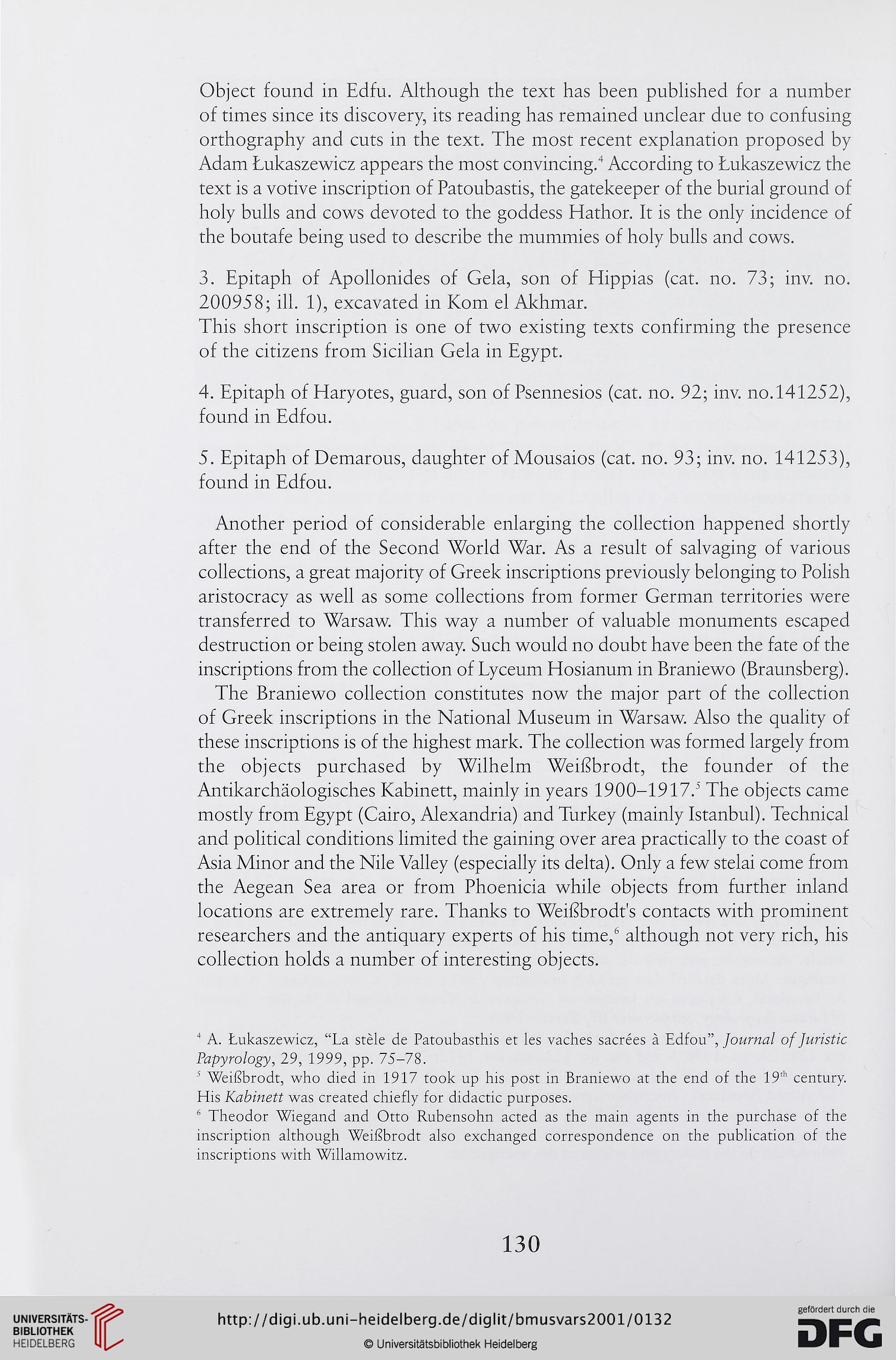Object found in Edfu. Although the text has been published for a number
of times sińce its discovery, its reading has remained unclear due to confusing
orthography and cuts in the text. The most recent explanation proposed by
Adam Łukaszewicz appears the most convincing.4 5 According to Łukaszewicz the
text is a votive inscription of Patoubastis, the gatekeeper of the burial ground of
holy bulls and cows devoted to the goddess Hathor. It is the only incidence of
the boutafe being used to describe the mummies of holy bulls and cows.
3. Epitaph of Apollonides of Gela, son of Hippias (cat. no. 73; inv. no.
200958; ill. 1), excavated in Kom el Akhmar.
This short inscription is one of two existing texts confirming the presence
of the citizens from Sicilian Gela in Egypt.
4. Epitaph of Haryotes, guard, son of Psennesios (cat. no. 92; inv. no.141252),
found in Edfou.
5. Epitaph of Demarous, daughter of Mousaios (cat. no. 93; inv. no. 141253),
found in Edfou.
Another period of considerable enlarging the collection happened shortly
after the end of the Second World War. As a result of salvaging of various
collections, a great majority of Greek inscriptions previously belonging to Polish
aristocracy as well as some collections from former German territories were
transferred to Warsaw. This way a number of valuable monuments escaped
destruction or being stolen away. Such would no doubt have been the fate of the
inscriptions from the collection of Lyceum Hosianum in Braniewo (Braunsberg).
The Braniewo collection constitutes now the major part of the collection
of Greek inscriptions in the National Museum in Warsaw. Also the ąuality of
these inscriptions is of the highest mark. The collection was formed largely from
the objects purchased by Wilhelm WeiBbrodt, the founder of the
Antikarchaologisches Kabinett, mainly in years 1900-19173 The objects came
mostly from Egypt (Cairo, Alexandria) and Turkey (mainly Istanbul). Technical
and political conditions limited the gaining over area practically to the coast of
Asia Minor and the Nile Valley (especially its delta). Only a few stelai come from
the Aegean Sea area or from Phoenicia while objects from further inland
locations are extremely rare. Thanks to WeiEbrodt's contacts with prominent
researchers and the antiąuary experts of his time,6 although not very rich, his
collection holds a number of interesting objects.
4 A. Łukaszewicz, “La stele de Patoubasthis et les vaches sacrees a Edfou”, Journal of Juristic
Papyrology, 29, 1999, pp. 75-78.
5 Weilśbrodt, who died in 1917 took up his post in Braniewo at the end of the 19th century.
His Kabinett was created chiefly for didactic purposes.
6 Theodor Wiegand and Otto Rubensohn acted as the main agents in the purchase of the
inscription although WeiSbrodt also exchanged correspondence on the publication of the
inscriptions with Willamowitz.
130
of times sińce its discovery, its reading has remained unclear due to confusing
orthography and cuts in the text. The most recent explanation proposed by
Adam Łukaszewicz appears the most convincing.4 5 According to Łukaszewicz the
text is a votive inscription of Patoubastis, the gatekeeper of the burial ground of
holy bulls and cows devoted to the goddess Hathor. It is the only incidence of
the boutafe being used to describe the mummies of holy bulls and cows.
3. Epitaph of Apollonides of Gela, son of Hippias (cat. no. 73; inv. no.
200958; ill. 1), excavated in Kom el Akhmar.
This short inscription is one of two existing texts confirming the presence
of the citizens from Sicilian Gela in Egypt.
4. Epitaph of Haryotes, guard, son of Psennesios (cat. no. 92; inv. no.141252),
found in Edfou.
5. Epitaph of Demarous, daughter of Mousaios (cat. no. 93; inv. no. 141253),
found in Edfou.
Another period of considerable enlarging the collection happened shortly
after the end of the Second World War. As a result of salvaging of various
collections, a great majority of Greek inscriptions previously belonging to Polish
aristocracy as well as some collections from former German territories were
transferred to Warsaw. This way a number of valuable monuments escaped
destruction or being stolen away. Such would no doubt have been the fate of the
inscriptions from the collection of Lyceum Hosianum in Braniewo (Braunsberg).
The Braniewo collection constitutes now the major part of the collection
of Greek inscriptions in the National Museum in Warsaw. Also the ąuality of
these inscriptions is of the highest mark. The collection was formed largely from
the objects purchased by Wilhelm WeiBbrodt, the founder of the
Antikarchaologisches Kabinett, mainly in years 1900-19173 The objects came
mostly from Egypt (Cairo, Alexandria) and Turkey (mainly Istanbul). Technical
and political conditions limited the gaining over area practically to the coast of
Asia Minor and the Nile Valley (especially its delta). Only a few stelai come from
the Aegean Sea area or from Phoenicia while objects from further inland
locations are extremely rare. Thanks to WeiEbrodt's contacts with prominent
researchers and the antiąuary experts of his time,6 although not very rich, his
collection holds a number of interesting objects.
4 A. Łukaszewicz, “La stele de Patoubasthis et les vaches sacrees a Edfou”, Journal of Juristic
Papyrology, 29, 1999, pp. 75-78.
5 Weilśbrodt, who died in 1917 took up his post in Braniewo at the end of the 19th century.
His Kabinett was created chiefly for didactic purposes.
6 Theodor Wiegand and Otto Rubensohn acted as the main agents in the purchase of the
inscription although WeiSbrodt also exchanged correspondence on the publication of the
inscriptions with Willamowitz.
130




